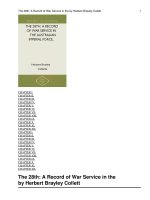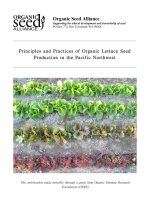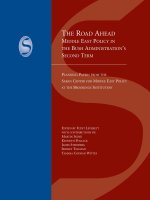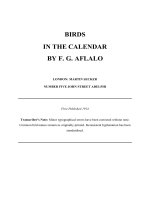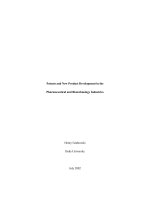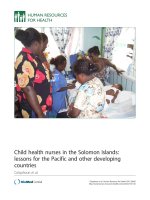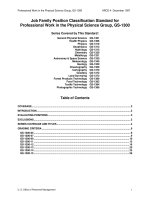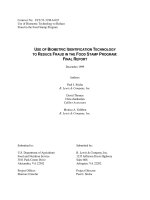Child health nurses in the Solomon Islands: lessons for the Pacific and other developing countries docx
Bạn đang xem bản rút gọn của tài liệu. Xem và tải ngay bản đầy đủ của tài liệu tại đây (1.59 MB, 9 trang )
Child health nurses in the Solomon Islands:
lessons for the Pacific and other developing
countries
Colquhoun et al.
Colquhoun et al. Human Resources for Health 2012, 10:45
/>RES E AR C H Open Access
Child health nurses in the Solomon Islands:
lessons for the Pacific and other developing
countries
Samantha Colquhoun
1*
, Divi Ogaoga
2
, Mathias Tamou
2
, Titus Nasi
2
, Rami Subhi
1
and Trevor Duke
1,3*
Abstract
Objectives: To understand the roles of nurses with advanced training in paediatrics in the Solomon Islands, and
the importance of these roles to child health. To understand how adequately equipped child health nurses feel for
these roles, to identify the training needs, difficulties and future opportunities.
Design: Semi-structured interviews.
Settings: Tertiary hospital, district hospitals and health clinics in the Solomon Islands.
Participants: Twenty-one paediatric nurses were interviewed out of a total of 27 in the country.
Results: All nurses were currently employed in teaching, clinical or management areas. At least one or two nurses
were working in each of 7 of the 9 provinces; in the two smaller provinces there were none. Many nurses were sole
practitioners in remote locations without back-up from doctors or other experienced nurses; all had additional
administrative or public health duties. Different types of courses were identified: a residential diploma through the
University of Papua New Guinea or New Zealand and a diploma by correspondence through the University of
Sydney.
Conclusions: Child health nurses in the Solomon Islands fulfill vital clinical, public health, teaching and
administrative roles. Currently they are too few in number, and this is a limiting factor for improving the quality of
child health services in that country. Current methods of training require overseas travel, or are expensive, or lack
relevance, or remove nurses from their work-places and families for prolonged periods of time. A local post-basic
child health nursing course is urgently needed, and models exist to achieve this.
Keywords: Solomon Islands, Child health, Nurses, Developing countries, Pacific Islands
Introduction
With the final push to achieve the Millennium Develop-
ment Goals (MDG), including that to reduce child mor-
tality rates, there is increasing recognition of the need
for strong health systems and comprehensive child health
programmes in the poorest countries. This will be just as
relevant beyond the MDG target date of 2015. Advances
in prevention and treatment of childhood illnesses, res-
ponses to emerging diseases and public health threats,
more detailed understanding of causes of morbidity and
child deaths, and an increased focus on neonatal health
have increased the complexity of child health since the
decade before the Millennium Goals were declared [1]. In
many countries this increasing technical and programme
complexity has not been matched with advances in pro-
viding a sustainable workforce that has the knowledge and
skills to support these advances [2].
The Solomon Islands child mortality rate has been
steadily falling since 1990, now estimated by the World
Health Organization (WHO) to be 27 per 1000 live births
[3]. Seventy five percent of child deaths in the Solomon
Islands occur in the first year of life [4]. In 2012 the
* Correspondence: ;
1
Centre for International Child Health, University of Melbourne, Royal
Children's Hospital, MCRI, 50 Flemington Road Parkville, 3052, Melbourne
Australia
3
School of Medicine and Health Sciences, University of Papua New Guinea,
Papua New Guinea
Full list of author information is available at the end of the article
© 2012 Colquhoun et al.; licensee BioMed Central Ltd. This is an Open Access article distributed under the terms of the
Creative Commons Attribution License ( which permits unrestricted use,
distribution, and reproduction in any medium, provided the original work is properly cited.
Colquhoun et al. Human Resources for Health 2012, 10:45
/>country has an estimated population of 542,000, with
more than 40% aged 15 years or less [5]. The most com-
mon causes of childhood deaths are pneumonia, malaria,
acute gastroenteritis, and meningitis, commonly compli-
cated by malnutrition. Among neonates the commonest
causes of death are complications of prematurity and low
birth weight, sepsis (skin infection, pneumonia, bacterae-
mia, ophthalmitis and cord infection) and birth asphyxia.
Other important childhood conditions include anaemia,
tuberculosis, worm infestation, rheumatic heart disease,
trauma, and bone and joint infections [4,6].
Access to medical care is difficult in the Solomon
Islands, because of long distances and dispersed islands ,
with 70% of the population living in remote or very re-
mote areas. Most seriously ill children present to pro vin-
cial hospitals, area health centres and clinics and need to
be cared for in their home provinces, rather than risk
the journey to the National Referral Hospital (NRH) in
Honiara by boat or small plane.
In the Pacific, the doctor/population ratio is among
the lowest in the world. In the Solomon Islands and
Papua New Guinea (PNG) the ratios are 11 and 7 per
100,000 population respectively [7], among the lowest in
Asia and the Pacific [8]. By con trast in Australia and
New Zealand there are 250 doctors per 100,000 people
in the population [7]. In Pacific countries nurses pre-
dominantly provide front-line management of sick chil-
dren, manage children’s wards, train junior staff, and
coordinate provincial and district public health and Ma-
ternal Child Health (MCH) programmes. This is done in
settings where supervision and input from medical staff
is sparse or unavailable. With the current scope of child
health it is unlikely that undergraduate nursing courses
can equip nurses to adequately deal with these more
complex roles and demands.
We sought to understand the contribution of child
health nurses to the Solomon Islands health system. We
explored their roles, the nurses’ perceptions of the appro-
priateness of their training to these roles, including
whether they felt equipped to address the complexity of
new child health and public health challenges, and their
continuing professional development needs. We reviewed
the health system and human resource context in which
these nurses worked.
Methods
Nurses who had undertaken any advanced training in
child health were identified by the Child and Reproduc-
tive Health Unit of the Ministry of Health in Honiara.
Data were obtained on each of the nurses, including
their current position and location of employment. The
nurses were contacted by radio or in person, and con-
sent to be interviewed was sought. Semi-structured
interviews were undertaken to obtain information across
an number of key areas , which included the course un-
dertaken and course components; a description of any
other training received in paediatrics; the nurses’ current
roles and support provided for them; the perceived li-
mitations and difficulties in undertaking these roles and
identification of additional duties such as teaching, data
collection and reporting or involvement in research. The
interviews consisted of 10 main questions. The questions
were designed to obtain information regarding the main
themes, with prompts to allow the nurses to discuss
their experiences at further length. At the end of the inter-
view nurses were asked to add any additional thoughts or
comments that they considered relevant for the inter-
viewers to know.
All nurses were interviewed in English with two in-
terviewers present, one of whom was also fluent in
Solomon Islands Pidgin. Interviews were done where
possible at the nurse’s place of work. All nurses gave
their permission to be interviewed. Interviews were re-
corded on a portable dictaphone and then transcribed
by the researchers who undertook the interviews. Add-
itional interviews and discussions to obtain background
data were done with medical dire ctors at two provincial
hospitals, the head of the Ministry of Health Child and
Reproductive Health unit, a paediatrician from Honiara,
and a junior doctor at a provincial hospital.
Data were reviewed by exploring each theme, identi-
fying common sub-themes and categorising comments.
Recorded interviews were stored in MP3 files, trans-
cribed and imported into NVivo 9 software (QSR In-
ternational 2011: to
undertake analysis. The project was approved by the
Solomon Islands Ministry of Health Ethics Committee.
All information provided was kept confidential and de-
identified.
Results
Description of Solomon Island nurses interviewed
We identified 27 nurses who had completed a post-basic
paediatrics course, and interviewed 21 of them (Table 1).
The majority trained at the University of Papua New
Guinea (UPNG) in Port Moresby. Of the fifteen nurses
who had completed the UPNG course, six had completed
a paediatrics course, which ran prior to 2004, and nine
had subsequently completed the combined paediatrics
and midwifery course. Twelve nurses had recently com-
pleted the distance learning course through the University
of Sydney, including three nurses who had graduated from
the UPNG residential course. Three other nurses had com-
pleted other residential courses in Auckland or at the
Adventist University in PNG.
One nurse was interviewed by two-way radio and the
other interviews were face-to-face. Of the two UPNG-
trained nurses not interviewed, one was working in a
Colquhoun et al. Human Resources for Health 2012, 10:45 Page 2 of 8
/>senior management position at the NRH in Honiara and
was unavailable during the period of the study, and the
other was working as a sole practitioner in a remote
clinic in Makira Province. At the time of the study the
two-way radio at this clinic was not functioning. Four
nurses who had completed the distance course were not
interviewed; all were working at the NRH in Honiara.
The nurses who had completed the post-basic paedia-
trics training through UPNG or an outside university were
distributed throughout the country in hospitals and remote
clinics. Those who undertook the distance course were
concentrated in the main hospitals in Honiara, Western
Province and Malaita province. There were no nurses w ith
paediatric qualifications in two out of the nine provinces:
Rennell-Bellona Province and Temotu Provine (Figure 1).
Roles of nurses interviewed
All nurses wer e currently employed in teaching, clini-
cal or management areas within the Solomon Islands
Government health or nursing education sectors (Table 2),
with the majority involved in clinical care. All 16 of
the UPNG/New Zealand (NZ)-trained nurses interviewed
were currently employed in senior roles as either nurses
in charge of paediatric wards in the referral or provincial
hospitals, sole clinicians working in remote and very re-
mote clinics, in education delivery, or as provincial child
health officers. Two of the nurses working at a provincial
hospital had spent six months of 2010 with no doctor at
their hospital or in the province. They ran the hospital in-
cluding paediatric and midwifery wards with support
available by telephone from Honiara.
Four nur ses were involved in major teachi ng roles; two
at Solomon Islands College of Higher Education, trai-
ning undergraduate nurses, and one at the Ministry of
Health, providing distance education modules by radio
to remote nurses. Two of these nurses had completed
their paediatrics cours e i n t he late 1990s and were
near retirement age. Another nurse was responsible for
Table 1 Paediatric courses completed by Solomon Islands nurses 1990 to 2011
Course (range of years nurses completed) Number Number interviewed
Advanced diploma in Paediatrics UPNG (1990-2003) 6 6
Advanced diploma in Paediatrics & midwifery UPNG (2004-05) 9 8
Advanced diploma in Paediatrics University of Auckland (1999) 1 1
Advanced diploma in Paediatrics Seventh Day Adventist University PNG (now discontinued) (2006) 2 1
IPPC, distance education course University of Sydney (2009-10) 12 5
Total 27
a
21
a
Three of the twelve nurses who completed the distance education course had also previously completed the UPNG course and are included above in the UPNG
course numbers.
Figure 1 Distribution of nurses interviewed.
Colquhoun et al. Human Resources for Health 2012, 10:45 Page 3 of 8
/>Table 2 Employment location and roles of child health nurses in Solomon Islands
Province Location Number Roles of the nurses
Nurses who had completed a post-graduate diploma outside Solomon Islands
Choiseul province Taro Hospital 2 Nurse 1: child health officer in province in charge of running MCH clinic at Taro,
responsible for clinical care, community outreach, public health for example,
collecting population-based data through the Family Health Card, and supervising
junior staff.
Nurse 2: nurse educator in charge of Choiseul province; coordinates all clinics and
outreach services with supervision from Provincial Medical Director.
Remote area health centre 1 Nurse 3: sole clinician working in remote clinic (> 4 hours by boat from nearest
hospital); responsible for clinical paediatric and midwifery care, liaises daily via
two-way radio with Taro hospital for support.
Western Province Gizo Hospital 2 Nurse 4: clinical nurse in charge of children’s, midwifery and male wards;
administrative and clinical supervisory duties.
Nurse 5: clinical nurse instructor; supervises and teaches undergraduate nursing
students on clinical rotation to children’s and midwifery wards.
Malaita Province Kil'ufi Hospital 2 Nurse 6: clinical nurse in charge of children’s, midwifery and emergency wards;
predominantly administrative and management role.
Nurse 7: charge nurse on children’s ward; responsible for management of ward,
staff rostering, supervising junior staff and clinical care.
Makira/Ullawa Province Remote area health centre 1 Nurse 8: senior nurse at remote health centre, accessible only by boat (> 3 hours
from provincial hospital). Responsible for clinical and public health care for
paediatrics and midwifery and administration; liaises daily via two-way radio
with Kirakira hospital for support.
Isabel Province Buala Hospital 2 Nurse 9: senior nurse in charge of clinical areas, children’s ward, midwifery and
medical wards; administrative, management and clinical duties.
Nurse 10: clinical nurse responsible for children’s ward and midwifery.
Central Province Tulaghi Hospital 1 Nurse 11: child health officer, responsible for child health for province, coordinates
public health programme and outreach including EPI, clinical responsibilities in
district hospital, supports junior nurses; clinic is 1 to 2 hours by boat to Honiara.
Guadalcanal Province Grove Hospital 1 Nurse 12: senior nurse in charge of divisional hospital clinical areas; clinical and
administrative duties, had worked for many years as sole clinician at a remote
area health centre 4 to 6 hours by boat and road from Honiara.
Honiara Children’s ward 1 Nurse 13: senior nurse in charge of children‘s ward, clinical, teaching, supervising,
management and administrative duties; also provided clinical support to
emergency department; had also completed distance course.
Neonatal ward 1 Nurse 14: senior nurse in charge; administrative, clinical, management and
supervising teaching duties.
Ministry of Health nurse
education unit
1 Nurse 15: education coordinator/nurse educator with senior teaching role;
responsible for delivery of radio-based course for nurses in remote areas; planning,
implementation and delivery of this curriculum.
Solomon Islands College
of Higher Education
1 Nurse 16: senior nurse lecturer; responsible for delivery of undergraduate nursing
curriculum, examining of students and assisting with post-graduate course
delivery.
Nurses who had completed IPPC course by distance learning via University of Sydney
Honiara National Referral Hospital
Children’s ward
5 Nurse 17: staff nurse in children’s ward; clinical responsibilities in acute setting.
Nurse 18: staff nurse in children’s ward; clinical responsibilities in acute setting.
Nurse 19: staff nurse in children’s ward; clinical responsibilities in acute setting.
Nurse 20: staff nurse in children’s ward; clinical responsibilities in acute setting.
Nurse 21: emergency and outpatients nurse.
Malaita Province Kilu'ufi Hospital 1 Nurse 22: clinical nurse consultant, senior nurse administrator; responsible for
management and administration of children’s wards, emergency and midwifery
and neonatal ward.
Colquhoun et al. Human Resources for Health 2012, 10:45 Page 4 of 8
/>coordinating nursing and medical services for remote pro-
vinces as the Ministry of Health education coordinator.
(Table 2).
Nurses in remote areas and provincial hospitals com-
monly provided radio support on a 24- hour basis to nur-
ses working in very remote areas as well as undertaking
outreach community visits to remote and very remote re-
gions of their provinces.
Nurses’ perceptions of their roles
A common theme was a feeling of being overwhelmed
by the scope of their ro le without the support of simi-
larly trained colleagues to rely on an d either no doctors,
or junior doctors with limited experience, to provide sup-
port and guidance. Nurses in clinical roles were com-
monly called upon after hours by other nurses with less
experience, or by junior doctors, to triage and manage sick
children.
‘We don’t have enough of the specialist nurses or doc-
tors that can do it (triage and look after very sick chil-
dren) so sometimes I have to come back 2 or 3 times at
night to assess the baby, to put up this IV The doctor
if he is junior he will always call us to come back to
manage the very sick child as he is not experienced and
he wants our advic e how to do it. But sometimes I just
want to see my family but it is always me that gets called
because I am the one with paediatric experience, there is
no one else.’
‘For six months last year we had no doctors at all. I do
the ward rounds, I do the admissions and discharges,
the consultation with the Honiara doctors by telephone
and they advise me to give this antibiotic or to send it
(the sick child) over.’
‘I am a clinical nurse consultant I look after the paedi-
atric ward, obstetric services and at the same tim e I am
a midwife and at the same time anything that happens
in the theatre I go to the theatre for caesarean sections
and I take calls on the radio from nurses in the periph-
ery when they need advice to treat.’
‘There as so many pikininis but too few nurses and
doctors who know how to provide acute care so it all
comes down to one or two of us and we can’t hope to
do everything and there is no one coming on behind us
to take over.’
Most nurses interviewed had administrative duties in
addition to their clinical roles. These consisted of super-
vising wards, organising staff rosters, reporting on basic
health statistics and completing reports to send to their
supervisors or the Ministry of Health. When asked whe-
ther they received feedback all nurses said ‘no never’;
when asked if feedback would be helpful they all stated
that it would be.
A number of nurses felt that there was much emphasis
on reproductive health with man y midwives trained and
working across the country, but little emphasis on sup-
porting or training child health nurses to manage com-
plex and difficult roles.
‘ the focus for many years from the Ministry has
been on reproductive health and family plan ning and
training more midwives, this is very importa nt but there
also needs to be support and focus on child health as
these babies are not babies for so long ’
The most common difficulties the nurses interviewed
faced were lack of similarly qualified colleagues. The ma-
jority of the nurses interviewed worked in remote or
very remote locations, some with responsibility for a dis-
trict or entire province.
Nurses’ experience with external advanced paediatric
courses
The initial inter view questions examined the nature of
each paediatric course attended by nurses, and its com-
ponents. The University of Papua New Guinea course
was seen by all nurses as being very beneficial to in-
crease their skills in paediatrics.
‘Hem barava (it was good/fantastic) helpful for gud
(good) especially in the rural clinic, hem (it was) really
helpful because we have no doctors and nobody else
there, so we just treat all childrens, only very serious
cases we need to call the doctor (by two-way radio) and
the other ca ses me pick hem up and treat hem pikinini
quickly.’
‘I was general nurse when they sent me over to PNG
so when I went there I learnt a lot from those people be-
cause before I don’t even know now to insert a drip in a
child or manage a sick child. It relates very well to me to
work in the remote hospital because now I know how to
manage it all, it’s a good thing for me because when I
see a sick child I know straight away that this child has
something or something else and I know how to manage
and treat this child myself now. It takes away the panic.’
Other comments related to the structure of the course
and rotation between theoretical units and the university
and clinical components undertaken in both the hospital
and the community.
‘There was theory and clinical practice. We learned
the theory and then we did the clinical practice and the
competencies for assessment as well as theory exams.
There was a lot of clinical practice, it was rotation on
the wards as well as some community where we went
out and spent eight weeks. We were supervised in the
wards, there were a lot of doctors and nurses there that
helped us learn and supervised us. We learnt a lot to
bring back with us to help our practice in the Solomons.
I was in the remote for a long time, that knowledge
helped me a lot there as there were no doctors.’
Nurses were satisfied with the content of the UPNG
paediatrics course, however all nine nurses who had
Colquhoun et al. Human Resources for Health 2012, 10:45 Page 5 of 8
/>undertaken the combined course in paediatrics and mid-
wifery had comments about the difficulty in meeting all
the clinical components and required competencies in the
10-month period available.
According to a paediatrician, Honiara, ‘It was very stress-
ful for the nurses to have to complete both (paediatric and
midwifery training) together in one year. So we stopped
sending the nurses PNG in 2007 as it is very expensive and
the course structure had changed for what we expected in
just paediatrics. We need many more paediatric nurses, es-
pecially in the provinces but we can only send a couple
each year so it would be better if we could start a course
here, the midwifery training has been very successful.’
Many nurses expressed difficulty with separation from
their family when they went to PNG for post-graduate
studies.
‘When I went to PNG to do my paediatrics course, it
was for one year and we couldn’t go home at all. I left
my small baby and my husban d an d I couldn’t see them
at all for nearly one year. That was the hardest thing.’
Nurses experience with overseas distance education
The distance education course (International Post gradu-
ate Paediatric Course- IPPC, through the University of
Sydney) [9] was perceived by the nurses to be interesting
but of limited relevance to their practice in the Solomon
Islands, and far advanced in terms of the level of mater-
ial presented and mode of delivery. The nurses were also
constrained by lack of technology, computers or internet
access to view the internet material or play the DVDs.
The course was first offered in the Solomon Islands in
2009, and was delivered at three main centres in the Solo-
mon Islands: NRH in Honiara, Gizo Hospital Western
Province, and Kilu’ufi Hospital in Malaita province. All
nurses interviewed were concerned by the lack of clinical
supervision and mentoring. The difficulties faced by the
nurses undertaking the IPPC were increased when the
course was delivered outside Honiara.
One nurse said: ‘It is difficult for us to do it here (IPPC
Course) we just need the support and some answers for
all the practicals, some supervision and resources, some-
times with this course you feel neglected, because at the
hospital you don’t have any time and no mentors and no
practical. We have some questions but the doctors are
too busy with the wards most of the time and so there is
no support either to do his work and help us with this
course. It is very hard for all or us and none of us pass
this course.’ Four out of the five nurses interviewed said
they thought the course was actually aimed at doctors.
The nurses stated that they found it interesting, but
unhelpful to learn about equipment and resources avai-
lable in Australia and ‘the luxury setting’ but not in the
Solomon Islands: ‘I think that the thing I want to say it
that they have to look at our setting, because in the
course like the treatments they have what ca n I say
they just have a different level, there in Australia. Be-
cause in the Solomon Islands we have still different
treatments and antibiotics. Some antibiotics that they’re
included in the treatments of the paediatric kids out
there, we don’t have it here. Some is appropriate, but they
need to see that the management is in line with what we
have and in our setting with the equipments and things
like that it is all very different than our setting.”
Discussion
Child illness and deaths remain high in the Solomon
Islands, as in many Pacific countries , and the number of
health workers is inadequate to provide the services
required. A comprehensive child health programme that
can further reduce child mortality and address significant
morbidity issues has many components; acute clinical
care, immunisation, nutrition, public health, coordination
of care for chronically unwell children. Each of these com-
ponents is increasingly complex, with the introduction
of new treatments, increasing antimicrobial resistance,
emerging disease threats, and the recognition of previ-
ously neglected areas (such as neonatal care, adolescent
health, child protection and disability). With these
demands, and the reality that there will not be sufficient
doctors to address these needs in remote areas in the Paci-
fic, there is a need to equip nurses with the skills required
in these areas.
The issue of child health nurses worldwide has
received almost no attention, despite the global push to
improve child survival. There have been few previous
studies examining the roles of child health nurses in
developing countries, and we could find only one from
Lesotho [10]. A few studies have focused on training
nurses in narrower speciality roles, such as paediatric
oncology [11], neonatal resuscitation [12], or the advanced
paediatric life support programme [13]. Invariably these
studies have focused on the contribution of nurses or
doctors from Western countries to the training of nurses
in developing countries [14]. There is no previous
study to have evaluated the long-term output and
outcomes of local child health nursing education in a
developing region.
This study provides evidence tha t nurses can fulfil the
roles required by a provincial health service in a deve-
loping country in the 21
st
century, long after they have
completed training. In the Solomon Islands, child health
and paediatric nurses were employed in vital clinical,
public health, management and teaching roles. Many
worked as sole practitioners in remote provincial set-
tings where there were no doctors. Most were called
upon to advise and assist junior doctors as they were the
clinicians with the most experience in child health at
their hospital or health centre. This has implications for
Colquhoun et al. Human Resources for Health 2012, 10:45 Page 6 of 8
/>paediatric care across the country, and creates opportun-
ities for an appropriate approach to the human res ource
of countries such as the Solomon Islands in this time,
towards and beyond the MDGs.
Overall, the nurses gave positive feedback about the
quality of training in the 12-month residential diploma
in paediatrics , or paediatrics and midwifery through
UPNG. A recurrent theme was relevance; that such cour-
ses, with their emphasis on clinical competency, men-
torship and supervision, equipped nurses to function
independently, particularly in remote, isolated settings.
However, the PNG paediatrics post-graduate course, and
support required to undertake it, is expensive at approxi-
mately (SI $180,000 per nurse per year). There is also a
drain of skilled staff, albeit temporarily, and overseas trai-
ning results in the removal of the nurse from the local
workforce for 12 months. Most concerning for nurses
involved in overseas training, was the separation from
their families and communities. No Solomon Island nur-
ses have been trained at the University of PNG since 2006
for reasons of cost, social dislocation and concern about
the combined midwifery and child health course not pro-
viding a sufficient level of competency. UPNG has now
reverted to single midwifery and child health programmes
because of concerns that the combined course did not
allow the students to obtain the required competency level
in the time provided, and these reforms have been posi-
tively received. However there is now only one post-basic
child health nursing course in PNG, where formerly there
were four. The advocacy for midwifery training, appropri-
ate given the high maternal mortality in the Pacific, has
overshadowed the need for training more child health
nurses and the need for re-establishing colleges who can
train such staff. Redressing of this imbalance is urgently
needed.
The nurses in this study who had had undertaken a
distance education certificate identif ied as challenges,
the lack of supervised clinical training , difficulties in
accessing the technology, and the inappropriateness of
the content and delivery method to the local setting.
Other local initiatives have attempted to address the
lack of training opportunities for nurses, inc luding a
programme for training provincial nurses on the man-
agement of seriously ill children using the WHO Pocket-
book of Hospital Care for Children. Two hundred nurses
in all provinces have been trained in the use of these
guidelines [15]. The Integrated management of Childhood
Illness (IMCI) training was also conducted in sele cted
provinces, but has not been scaled up nationally [16].
Inter viewed nurses concluded that there wa s a need
for in-country post-graduate training for nurses in
child health. The current numbers of post-graduate
child health nurses provide inadequate and fragmen-
ted cover.
This study has demonstrated the need for advanced
paediatric trained nurses in the Solomon Islands, and its
value in equipping nurses who work in remote areas
with capacity to fulfil the roles required of them. Current
modes of delivery have not been able to fulfil this need
according to the nurses interviewed. More than 120 gra-
duates from the Solomon Islands post-graduate midwi-
fery course, facilitated jointly by the Ministry of Health
and Solomon Islands College of Higher Education for
over 15 years, are now widely distributed throughout the
Solomon Islands. This has been a substantial success.
This success could be replicated with a locally delivered,
content-appropriate nursing course in paediatrics and
child health. The content of such a course would be
based on the child health needs of the Solomon Islands,
and draw upon the many training resources and standards
from WHO, United Nations Children’s (Emergency) Fund
(UNICEF) and other agencies in recent years [15-18], and
would also draw upon the UPNG course.
There are resource implications. However many of the
ingredients are in place and this type of course can be
relatively low budget yet still of high quality. Such a
course is ideally practically based, therefore, much of the
training would be conducted in the paediatric ward at
the NRH. This requi res input from clinical teachers and
paediatricians; however, there is a benefit to quality of
care even while the students are training. This is because
of the increased focus on clinical teaching, and the level
of critical enquiry that ensues from becoming a teaching
institution. There are classrooms at most major hospitals
for theoretical teaching, so infrastructure requirements
are minimal. The public health teaching required for
such a course is largely practical, and requires involve-
ment of public health branches of the health depart-
ment, both national and provincial, plus travel to rural
areas for practical experience of public child health pro-
grams. Clinical nurse teachers need higher training, and
most nursing colleges in the Pacific require teachers and
lecturers to be trained to Master’s level in nursing or
education. This could be facilitated in collaboration with
universities in Australia. However even if provided for
only two or three nurse teachers (the number required
to establish a course training 15 to 20 paediatric nurses
per year), this would require substantial funding. Higher
degree education in Australia is expensive at approxi-
mately AU$25,000 for a Master’s degree, plus travel and
living expenses, which can cost an additional $40,000 a
year. The graduates of a paediatric nursing course would
require professional and legal recognition and accredit-
ation for a wider scope of practice. There are precedents
in midwifery, but changing accreditation and legal recog-
nition requires political will and action, as well as mo-
dest but ongoing funding for higher wages for specialist
nurses.
Colquhoun et al. Human Resources for Health 2012, 10:45 Page 7 of 8
/>Conclusions
A local paediatric nursing cour se in the Solomon Islands
would take candidates from all provinces, and would build
strong knowledge and skills for child health throughout
the country, and develop a professional network for lea-
dership and advocacy for child health.
Competing interests
TD has an honorary appointment at the School of Medicine in University of
PNG where one of post-graduate paediatric nursing course is offered. The
Centre for International Child Health and TN have been actively involved in
training for nurses on the WHO Pocket Book of Hospital Care for Children in
Solomon Islands. No authors have any financial conflict of interest with the
themes or issues presented in this paper.
Authors’ contributions
SC, TD, RS and DO designed the study. SC and MT were involved in the
interviews and data collection. SC and TD wrote the paper, and all authors
had inputs into various versions. All authors read and approved the final
manuscript.
Acknowledgements
The Centre for International Child Health is a World Health Organization
Collaborating Centre for Research and Training in Child and Neonatal Health.
This work is supported by AusAID as part of the Knowledge Hubs for Health
initiative, and by the R. E. Ross Trust (Victoria).
Author details
1
Centre for International Child Health, University of Melbourne, Royal
Children's Hospital, MCRI, 50 Flemington Road Parkville, 3052, Melbourne
Australia.
2
Ministry of Health, Solomon Islands.
3
School of Medicine and
Health Sciences, University of Papua New Guinea, Papua New Guinea.
Received: 29 May 2012 Accepted: 9 November 2012
Published: 21 November 2012
References
1. Lozano R, Wang H, Foreman KJ, Rajaratnam JK, Naghavi M, Marcus JR:
Progress towards millennium development goals 4 and 5 on maternal
child mortality: an unpdated systematic analysis. Lancet 2011,
378:1139–1165.
2. Subhi R, Duke T: Leadership for child health in the developing countries
of the Western Pacific. J Global Health 2011, 1:96–104.
3. World Health Organization: Solomon Islands: health profile; 2012.
/>4. Parks W: Achieving results for pacific island children: UNICEF's analysis of
and response to pacific millenium development goal progress. Policy
Quarterly 2009, 5:20–27.
5. Solomon Islands national statistics office; 2012. />country/sb/stats/MDG/Goals/Goal6.htm.
6. Auto J, Nasi T, Ogaoga D, Kelly J, Duke T: Hospital services for children in
Solomon Islands: rebuilding after the civil conflict. J Paeds Child Health
2006, 42:680–687.
7. Watters DAK, Scott DF: Doctors in the Pacific. Med J Aust 2004, 181:597–601.
8. Henderson LN, Tulloch J: Incentives for retaining and motivating health
workers in Pacific and Asian countries. Human Resources for Health 2008,
6:1–20. [ />(accessed April 2010).
9. International post-graduate paediatrics course; 2012. [ />about-us/dch-ippc-brochure.pdf]. 2012 (accessed May 2012).
10. Moiloa T, Wilson ME: Child health and pediatric nursing in the Kingdom
of Lesotho. J Pediatr Nurs 1995, 10:393–397.
11. Ribeiro RC, Steliarova-Foucher E, Magrath I, Lemerle J, Eden T, Forget C,
Mortara I, Tabah-Fisch I, Divino JJ, Miklavec T, Howard SC, Cavalli F: Baseline
status of paediatric oncology care in ten low-income or mid-income
countries receiving My child matters support: a descriptive study. Lancet
Oncol 2008, 9:721–729.
12. Carlo WA, Wright LL, Chomba E, McClure EM, Carlo ME, Bann CM, Collins M,
Harris H: Educational impact of the neonatal resuscitation program in
low-risk delivery centers in a developing country. J Pediatr 2009,
154:504–508.
13. Young S, Hutchinson A, Nguyen VT, Le TH, Nguyen DV, Vo TK: Teaching
paediatric resuscitation skills in a developing country: introduction of
the advanced paediatric life support course into vietnam. Emerg Med
Australas 2008, 20(271):275.
14. Garfield RM, Berryman E: Nursing and nursing education in Haiti. Nurs
Outlook 2012, 60:1–20.
15. World Health Organization: Hospital Care for Children: Guidelines for the
Management of Common Illnesses with Limited Resources. Geneva: WHO;
2005 [http//www.who.int/child-adolescent-health/publications/
CHILD_HEALTH/PB.htm] and [www.ichrc.org.]
16. World Health Organization: IMCI Guidelines. Geneva: Chartbook; 1997 [http://
ww.who.int/child-adolescent-health/publications/IMCI/chartbooklet.htmw.].
17. World Health Organization: WHO Immunization in Practice. Geneva: A
Practical Resource Guide for Health Workers; 2004 [www.who.int/vaccines-
documents/DoxTrng/h4iip.htm.]
18. World Health Organization: The Baby Friendly Hospital Initiative: WHO; 2010.
[ />(accessed May 7th 2010).
doi:10.1186/1478-4491-10-45
Cite this article as: Colquhoun et al.: Child health nurses in the Solomon
Islands: lessons for the Pacific and other developing countries. Human
Resources for Health 2012 10:45.
Submit your next manuscript to BioMed Central
and take full advantage of:
• Convenient online submission
• Thorough peer review
• No space constraints or color figure charges
• Immediate publication on acceptance
• Inclusion in PubMed, CAS, Scopus and Google Scholar
• Research which is freely available for redistribution
Submit your manuscript at
www.biomedcentral.com/submit
Colquhoun et al. Human Resources for Health 2012, 10:45 Page 8 of 8
/>
